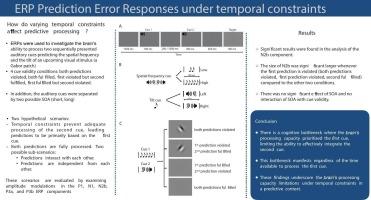ERP prediction error responses under temporal constraints
IF 2.6
4区 医学
Q3 NEUROSCIENCES
引用次数: 0
Abstract
Anticipating future events is fundamental to adaptive behaviour. This study used EEG to examine how the brain processes multiple concurrent predictions under time constraints. On each trial, participants heard two auditory cues predicting different features (tilt and spatial frequency) of an upcoming visual stimulus (a Gabor patch), with cues presented either 200 ms or 1000 ms apart. The visual stimulus could either match both predicted features, violate both, or match only one while violating the other. We analysed event-related potentials (ERPs) to the Gabor patch to assess prediction error (PE) responses. Violations of the first cue’s prediction consistently elicited robust N2b responses, even when the second cue’s prediction was accurate. Violations of both cues produced similarly strong N2b amplitudes, while isolated violations of the second cue had no significant effect. No differences emerged between short and long cue intervals, suggesting that the temporal gap did not modulate PE processing. These results point to a bottleneck in integrating sequential predictions, with earlier cues dominating PE-related EEG responses under temporal constraints.

时间约束下ERP预测误差响应
预测未来事件是适应性行为的基础。这项研究使用脑电图来检查大脑如何在时间限制下处理多个并发预测。在每次试验中,参与者听到两个听觉线索预测即将到来的视觉刺激(Gabor patch)的不同特征(倾斜和空间频率),线索间隔200毫秒或1000毫秒。视觉刺激可以匹配两个预测特征,也可以违反两个预测特征,或者只匹配一个而违反另一个。我们分析了Gabor补丁的事件相关电位(ERPs)来评估预测误差(PE)反应。即使第二个线索的预测是准确的,违反第一个线索的预测也会引起强烈的N2b反应。违反这两个线索会产生相似的强N2b振幅,而单独违反第二个线索则没有显著影响。短提示间隔和长提示间隔之间没有差异,表明时间间隔没有调节PE加工。这些结果指出了整合顺序预测的瓶颈,在时间限制下,早期线索主导着pe相关的脑电图反应。
本文章由计算机程序翻译,如有差异,请以英文原文为准。
求助全文
约1分钟内获得全文
求助全文
来源期刊

Brain Research
医学-神经科学
CiteScore
5.90
自引率
3.40%
发文量
268
审稿时长
47 days
期刊介绍:
An international multidisciplinary journal devoted to fundamental research in the brain sciences.
Brain Research publishes papers reporting interdisciplinary investigations of nervous system structure and function that are of general interest to the international community of neuroscientists. As is evident from the journals name, its scope is broad, ranging from cellular and molecular studies through systems neuroscience, cognition and disease. Invited reviews are also published; suggestions for and inquiries about potential reviews are welcomed.
With the appearance of the final issue of the 2011 subscription, Vol. 67/1-2 (24 June 2011), Brain Research Reviews has ceased publication as a distinct journal separate from Brain Research. Review articles accepted for Brain Research are now published in that journal.
 求助内容:
求助内容: 应助结果提醒方式:
应助结果提醒方式:


